-
Posts
11,151 -
Joined
Content Type
Profiles
Forums
Store
Help Articles
Posts posted by slkinsey
-
-
I think we've solved the mystery of your "bag bloat." If this is your short ribs and mushrooms after sealing, it doesn't have nearly enough air removed before sealing. To my eye, there is still plenty of air in there. The bag should be tight on all the food.
-
More sous vide experimentation. This time it was chicken breasts with scallions and shitakii mushrooms. I bagged it all together with the FoodSaver and cooked it for 40 minutes in a 65C water bath. Nothing else in there but some salt, white pepper and around a teaspoon of rendered chicken fat from the freezer. Yea, yea. . . I know I could have gone for a lower final temperature, but as this was the first time I wanted to make sure it had a familiar "cooked chicken" texture.
Here are some looks at the bag after it came out of the water bath:
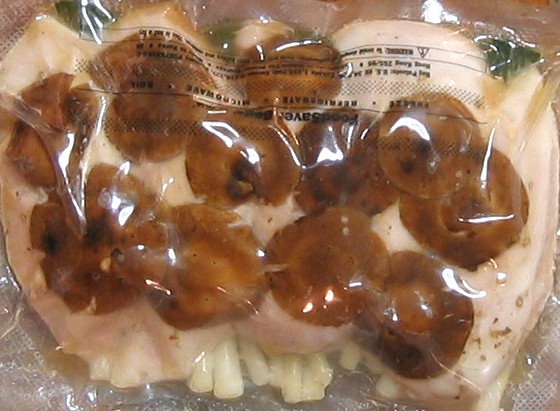
Mushroom Side
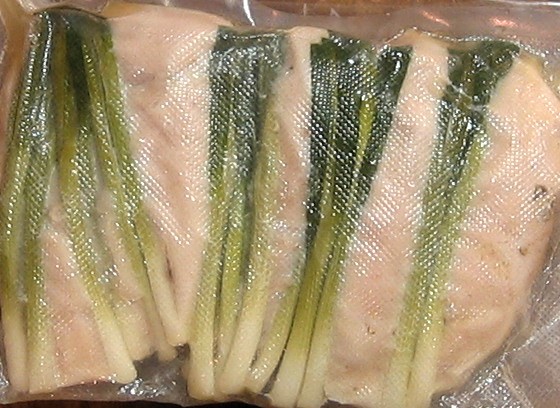
Scallion Side (the vacuuming sucked the scallions into the "valleys" between breasts)
Here are the results. Incredibly moist and tender, and exquisitely perfumed with shitakii and scallion. The juices in the bag made a very nice, light "sauce" that I poured over the chicken.

On the Platter
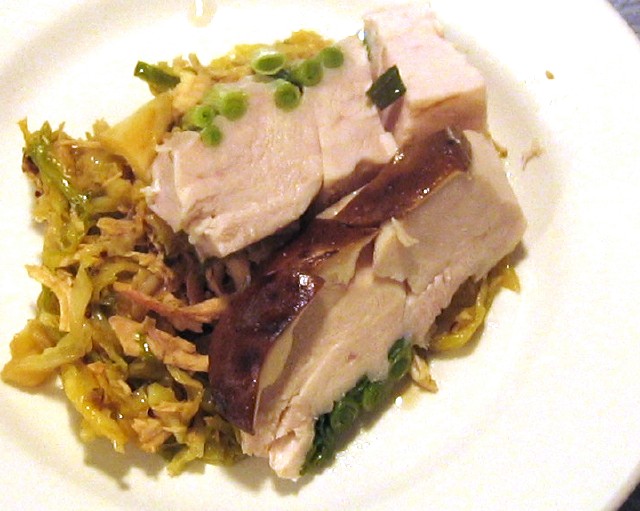
With Wilted Savoy Cabbage (I think this gives some idea of how moist the chicken is)
This really couldn't have been easier, too. And hardly anything to clean up! With Nathan's charts, it's very easy to get started.
Next time: fish.
-
 1
1
-
-
spatchcocked chicken
That's a new one to me (not that I am anything but a novice!). What is it?
-
Aside from price considerations, since I am already planning to buy a saucier in the 11", do you think that it would make more sense to get the smaller one in the fait tout/straight sided configuration instead of curved? I know--you wanna know what I am going to use it for--well--sauces in small quantities (for one or two people), as well as more pedestrian uses where a saucier is overkill.
Either/or, really. A lot of people like the curved sides for sauce making. I have a small regular sauteuse evasee and medium curved sauteuse evasee. I like them about equally.
As with you, I noticed I could keep a higher heat for searing steaks or chickens etc. When making jus, and have a pan full of scraps to brown, the copper will lose heat and so become 'sticky' much faster than the old cast iron. I also have some s/s pieces from an Italian range of pans - the company is calle Pentole - that I've only ever seen in the UK. I believe they have a copper core. Regardless, the (even) heat they maintain is unbelievable, certainly higher than the mauviel. Not what I was expecting.If the thermal mass is higher then, all other things being equal, it will hold temperature better. Of course, if the thermal mass is higher and the thermal conductivity is lower, it just magnifies the difference. FWIW, from what I have been able to glean, I suspect your ICM Cose Casa "Le Pentole" cookware is not copper core, but rather heavy stainless with a thick encapsulated aluminum base. One would expect better heat retention from such a design.
Personally, I prefer heavy stainless body with an extra-thick aluminum base for a saute pan. I think it balances the need for a high heat capacity with some responsiveness and no reactivity. I can't say that I've experienced the situation you describe with my heavy copper frypans (losing heat and getting "sticky"), but my gas stove also puts out a considerable flame for a regular NYC apartment stove. The more heat you can pour into the copper pan (i.e., the more powerful your heat source) the less likely you are to experience any heat loss issues with heavy copper. It's when you pull the copper pan off the stove and put it in the oven, where the heat transfer to the pan is drastically reduced, that you would really rather have low thermal conductivity instead of high.
-
According to the Dietary Supplement Health and Education Act of 1994. . .
<br />§3. Definitions.<p></p><li><b>( a ) Definition of Certain Foods as Dietary Supplements.</b> Section 201 ( 21 U.S.C. 321 ) is amended by adding at the end the following:</li>
<p></p>
"( ff ) The term "dietary supplement" -
<ul>
<li>"( 1 ) means a product ( other than tobacco ) intended to supplement the
diet that bears or contains one or more of the following dietary ingredients:</li>
<ul>
<li>"( A ) a vitamin;</li>
<li>"( B ) a mineral;</li>
<li>"( C ) an herb or other botanical;</li>
<li>"( D ) an amino acid;</li>
<li>"( E ) a dietary substance for use by man to supplement the diet by increasing the total dietary intake; or</li>
<li>"( F ) a concentrate, metabolite, constituent, extract, or combination of any ingredient described in clause ( A ), ( B ), ( C ), ( D ), or ( E );</li>
</ul>
<li>"( 2 ) means a product that -</li>
<ul>
<li>"( A )( i ) is intended for ingestion in a form described in section 411( c )( 1 )( B )( i ); or</li>
<li>"( ii ) complies with section 411( c )( 1 )( B )( ii );</li>
<li>"( B ) is not represented for use as a conventional food or as a sole item of a meal or the diet; and</li>
<li>"( C ) is labeled as a dietary supplement; and</li>
</ul>
<li>"( 3 ) does -</li>
<ul>
<li>"( A ) include an article that is approved as a new drug under section 505, certified as an antibiotic under section 507, or licensed as a biologic under section 351 of the Public Health Service Act ( 42 U.S.C. 262 ) and was, prior to such approval, certification, or license, marketed as a dietary supplement or as a food unless the Secretary has issued a regulation, after notice and comment, finding that the article, when used as or in a dietary supplement under the conditions of use and dosages set forth in the labeling for such dietary supplement, is unlawful under section 402( f ); and</li>
<li>"( B ) not include -</li>
<ul>
<li>"( i ) an article that is approved as a new drug under section 505, certified as an antibiotic under section 507, or licensed as a biologic under section 351 of the Public Health Service Act ( 42 U.S.C. 262 ), or</li>
<li>"( ii ) an article authorized for investigation as a new drug, antibiotic, or biological for which substantial clinical investigations have been instituted and for which the existence of such investigations has been made public,</li>
</ul>
</ul>
</ul>
which was not before such approval, certification, licensing, or authorization marketed as a dietary supplement or as a food unless the Secretary, in the Secretary's discretion, has issued a regulation, after notice and comment, finding that the article would be lawful under this Act.<br />
</ul>
Except for purposes of section 201( g ), a dietary supplement shall be deemed
to be a food within the meaning of this Act.
(Note: this material not subject to copyright protection)
-
And where is the line between "dietary supplement" and food ingredient anyway?
That's an interesting question. It definitely seems to be the case that some things are allowed to be sold unregulated in certain forms, regulated in other forms and not at all in other forms.
-
From a homebrewer's point of view, I still need access to bitter orange peel in ounce sized doses to toss into my brew kettle. Even if liquers and pre-made beers are exempt, those of us who make our own are still potentially affected by this.
I see what you're saying, I just don't agree that it's something to be concerned about. You can still get wormwood, can't you? I don't think we're in any danger of seeing the government ban the sale of all bitter orange peel. The only potential issue would be if the FDA were to ban dietary supplements containing bitter orange peel. One could still buy ephedra herb legally in the US even while the FDA ban on ephedra supplements was in effect, because the FDA ban only applied to dietary supplements containing ephedra. Regardless, in April of 2005 a judge in Utah overturned the FDA ban on ephedra supplements and told the FDA they would have to do more testing to determine safe levels if they wanted to continue the ban. Very few companies are coming to market with ephedra supplements after the lift, most likely because of liability issues and concerns that the public won't buy it after the negative publicity.
So, again, I have very little fear that we will see a ban of any kind on bitter orange peel in the forseeable furure.
And what about access to bitter oranges like Sevilles? They're tough enough to get ahold of as it is. Finding a black market for them would be close on to impossible.Look on the bright side: if they ban bitter orange peel dietary supplements, that means that there will be even more available for brewing and other culinary applications.
 And orange bitters? The stuff is almost a pure tincture of bitter orange peel, no? At least according the the Baker formulation.
And orange bitters? The stuff is almost a pure tincture of bitter orange peel, no? At least according the the Baker formulation.There is plenty of other stuff in the two orange bitters with which I am familiar (Fee's and Regan's). Plus, I have to believe that you'd have to drink an awful lot of orange bitters to get a dose equivalent to one of those diet pills.
-
Interesting. Whether a piece of heavy copper loses a lot of heat when, for exmple, introduced to a large piece of meat depends on a lot of variables: how hot was the pan preheated, how high is the flame, how powerful is the stove, what kinds of heat source are you using, how large is the piece of meat, is the pan being taken off the heat and put into the oven, and if so how soon, etc.
There is little doubt that cast iron or stainless with a thick aluminum disk bottom is the better choice for certain food items and for certain cooking tasks. However, I usually find that I wish cast iron cookware was substantially heavier than it is. There is often only a marginal difference in the heat capacity of similar sized heavy copper and cast iron pieces, and most cast iron pieces are not thick enough to avoid significant hotspot problems.
That said, I'll usually reach for some of my old cast iron if I'm going to be searing a steak or a pork chop and finishing it in the oven. I don't often use cast iron for something like a spatchcocked chicken I'm starting skin side-down on the stove and finishing in the oven, but that is simply a shape issue: I don't find the cast iron skillet shape to be very good for this task and prefer a frypan shape. If they made large extra-heavy cast iron pans with low sloping sides I'd use them.
I'm curious. . . what kinds of things do you do where you feel that copper loses heat for you?
-
I'm not convinced that this will be a problem that affects the brewing or liqueur industries. There are plenty of things used in herbal infusions and brewed into beer that are dangerous when consumed in the massive megadoses used in diet pills. I think regulation is moving more in the direction of allowing small amounts of these suposedly "dangerous" substances to be used in traditional beverages. For example, real absinthe is becoming legal all over Europe and I think it's only a matter of time before it's legal here. And yet, thujone is a dangerous poison. For that matter, it's quite easy to kill yourself in short order with another common poison: nicotine. No way is whatever there is in bitter orange peel as dangerous as thujone or nicotine. If anything comes of this (which I think is doubtful) it will hopefully be the banning of megadose bitter orange peel diet pills.
Is there anything taken as a diet pill that isn't bad for you?
-
Let's keep all the discussion in one thread -- the one cdh links to.
-
What purpose does the H2O have?
It's such a dense, viscous, strongly flavored cocktail that I assume the water is necessary just to provide additional dilution beyond the normal 20% you'd get from shaking. Many of the ingredients are so intensely flavored that the drink really needs to be thinned out quite a bit. Think about what you're getting in each serving minus the water: 2/3 ounce genever, 1/2 ounce rich simple syrup, 1/2 ounce Chartreuse, 1/2 ounce heavy rum and a teaspoon each of orange curaçao and Angostura bitters. That's just too much strong flavor and too much sweetness without taking extreme measures to thin the drink. It's incredibly strongly flavored even with the additional dilution. That's my guess, anyway. It is odd, though, isn't it? It's the only recipe I can recall that calls for water.
-
That's spelled: Mojito Criollo.
I always thought the difference between a regular Mojito and a Mojito Criollo is that the former is made with regular ice cubes and the latter is made with crushed ice. Yes?
-
It's a good sign that this book is a year old and I'm still enjoying it.
I take issue with one or two of the formulations (in particular the Pegu Club recipe, which is both way off and strangely ahistorical given the premise of this book), but all in all I think it's a wonderful book and many of the formerly forgotten cocktails it features have entered the standard repertoire not only at the slkinsey household but in many of the better NYC watering holes.
So, having finally procured some genever, and having temporarily sated my craving for the Improved Holland Gin Cock-Tail, it was time to try one of the more peculiar drinks from Vintage Spirits and Forgotten Cocktails, the Alamagoozlum. This is a very unusual cocktail given the long list of disparate ingredients as well as the fact that the recipe makes three cocktails rather than just one. I'm going from memory here, but it goes something like this:
Alamagoozlum
2.0 oz : genever
2.0 oz : water
1.5 oz : Jamaican rum
1.5 oz : Green or Yellow Chartreuse (I used green)
1.5 oz : gomme syrup (I used 2:1 simple syrup)
0.5 oz : orange curaçao
0.5 oz : Angostura bitters
one half of an egg white
Shake all ingredients with ice hard, like your very life depends on it, until very, very cold. Strain into three cocktail glasses.
As you may imagine, this is a very spicy cocktail and there are a lot of flavors going on -- but somehow they all play well together. I would call this a cocktail for late fall/early winter due to the rich, sweet spicyness. It's like pumpkin pie in a glass. Interestingly, it's also quite thick and viscous on the palate, unlike any other cocktail I've had. Has anyone else tried this one? Any other interesting or strange discoveries from Vintage Spirits and Forgotten Cocktails?
-
Hmmm. That is an awful lot of bloating. But I think I have read that certain vegetables tend to be gassy when cooked. Perhaps the mushrooms? Or the alcohol from the wine? Others will know more about this than I.
-
Bag bloating is supposed to be an issue with FoodSaver bags compared to bags vacuumed and sealed by the commercial machines. I don't think it's a big deal from a safety standpoint, as long as you cook for a sufficient length of time (there is safety information in the main sous vide thread).
How much air are you talking about? I just did a bunch of short ribs for around 30 hours at 60C using a FoodSaver bag and a circulating bath with very little air showing up in the top of bag. That said, I carefully positioned the short ribs in the bag to minimize any hidden air pockets, I did an extended vacuum before sealing, and after sealing I sealed the bag again much closer to the meat (essentially eliminating a lot of extra bag space to which air or liquid might migrate).
What do you have in the bag besides short ribs?
-
I don't own the seven inch Falk curved sauteuse evasée, but I do own the regular straight sided sauteuse evasée in the 1 quart size. It is not particularly "tippy."
If a small saucepan has a tendency to tip over unless it is full, I think that's an indication that it is not very well designed. A piece of cookware should balance. Also, I think it's likely that such a pan would be constructed from poor materials anyway -- most likely thin stainless steel -- if the handle is almost the same weight as the body.
-
This is just a "trendy looking" version of Bialetti's Moka Express. It's a perfectly good moka pot, if that's a kind of coffee you like. But it's not espresso by any means. I think the Bialetti Brikka is really a better moka pot.
Here is a good thread on moka that you may find informative.
-
So, after discovering that my Lauda MS was defective and finding a Lauda B instead, I was finally ready to do my first sous vide experiment this weekend. I cooked beef short ribs at 60C for 30 hours. The short ribs were not browned before or after. I had trimmed the external fat from the short ribs beforehand, had rendered out the fat and had used the meat scraps and a few of the smallest bones to make around a quarter cup of super-concentrated beef stock. Both were frozen and added to the bag with the short ribs before I sealed it. Here is the result:
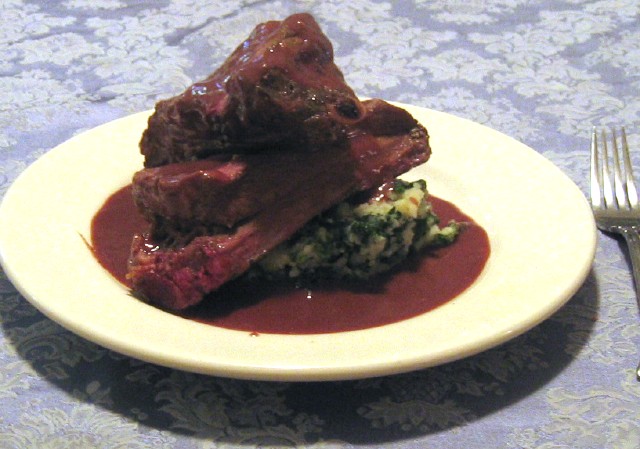
I made a sauce out of the defatted liquid from the bags. This tasted much more like a gravy made from roast drippings than it did a sauce made with stock. Very interesting. I served it with kale and smoked garlic mashed potatoes.

As you can see, the meat is quite pink (ambient light)
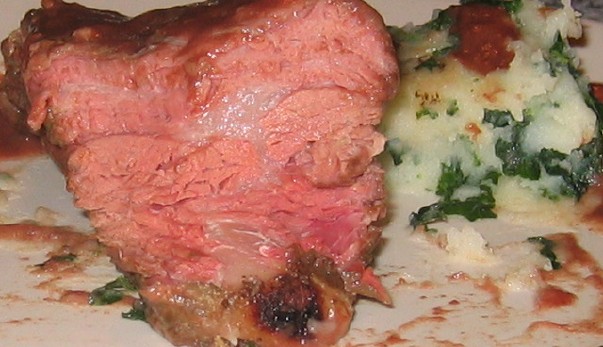
Here is another look at the meat (with flash)
It was very interesting. Next time, I think I'd go longer with the cooking. It was very tender with some resistance. Not dissimilar from a strip steak, I'd say -- which is to say that it wasn't cut with a spoon tender. But it was quite interesting to eat what was more or less medium rare short rib that was tender like that.
More thoughts later. . .
-
Here's the thing about lever espresso machines: It is theoretically possible to get the best shot of espresso with a lever machine, because the barista (you) can completely control the pressure, extraction, etc.
But (and it's a big but) the learning curve is 100 times steeper than it is with a semiauto pump machine. So, unless you are willing to invest a lot of time building and maintaining your technique, you are actually unlikely to ever produce a shot that is comparable with everyday shots from a machine like the Rancilio Silvia. I have friends who have been using a lever machine for years and swear by lever action, and yet I have never had a shot from their machine that is as good as the shots my Rancilio was producing after only one week of tweaking.
-
A ratio of 2:1 or 1:1 is what one is likely to find in recipe books dating from the glory days of the Martini, and I have come around to thinking that it is best. The Martinis people were throwing back in the old Thin Man movies and the like would have been 1:1 or 2:1 Martinis at around three ounces (in his opening scene Nick Charles throws one down in one sip, which gives you an idea of the size). 1:1 with a drop of orange bitters is the way Audrey Saunders is making them at Pegu Club.
Try 1.5 ounces each of Tanqueray or Boodles with 1.5 ounces of Noilly Prat, a drop of orange bitters and a lemon twist. I think it might change the way you think about a Martini.
-
The Ti Punch is actually an interesting subject in the discussion of Swizzles. A Ti Punch is nothing more than ruhm agricole, a bit of cane syrup and a disk of lime peel, mixed and swizzled with crushed ice (although I understand that it was probably originally not made with ice at all).
So is a Ti Punch a "Swizzle," or is it rather a "drink that is swizzled"? To my mind there is a difference, but I am willing to be set straight.
-
i think if psaltis had shown a sense of humor about himself or even a sense of humility, the reaction to his having left out inconvenient facts wouldn't have been nearly so strong.
Yes, I absolutely agree. This is part of what I was getting at when I said that AB's writing makes people like him and that it's one of DP's weaknesses in his book. But you say it better.
That said, isn't it generally par for the course for people at DP's stage in the game to be headstrong and arrogant? I wonder if the book would have had a much different tone if it were written 5 years from now, even if the content and opinions were mostly the same.
-
I've noticed a different viscosity between the syrups I make with white sugar and with demerara; the latter seems much thicker.
Interesting. I usually make demerara syrup at 2:1 and white syrup at 1:1 (these are the concentrations usually specified in the recipes I use). It strikes me that a 2:1 white syrup would normally have a greater concentration of syrup than a 2:1 demerara syrup simply because most demerara sugar comes in big chunky crystals whereas white sugar usually comes in fine granules. As a result, a cup of fine white sugar contains more sugar than a cup of rough demerara sugar. On the other hand, some health food stores have demerara sugar granulated so fine it is almost powder. If you're using that, it would of course produce a syrup with greater concentration than white.
When making cocktails at home with 2:1 simple syrup from the refrigerator, it's always a good idea to put the syrup bottle into a pan of warm water while you're getting the rest of your ingredients together. That way it will pour just fine by the time you're ready to add the syrup to the shaker.
-
Do you suppose that your friend Tony Bourdain hasn't left some unflattering things about himself out of his books, or indeed any items that others familiar with the various situations described might consider significant omissions?
If tony left anything unflattering about himself out in his book, it was only because it was either boring or not applicable. I'd say he came pretty clean. i haven't heard anyone call him a liar, and surely they would have by now.
(First I should point out that I'm using AB as an example merely because he is a convenient and well-understood one, not because I have anything to say about him in particular. I like him and his work.)
So, here's the thing: Who decided what was boring or not applicable? Tony, of course. So it's possible that some things were left out that other people might find important. It also seems possible to me that one reason no one has come out to call Tony a liar (or one reason you haven't heard about it anyway) is that many of the people described in the book who might care to do so are not important enough for anyone to listen to them. I mean, it's hardly likely that a discussion like this would be happening if a few Puerto Rican line cooks had said "there was no drunken ass-grabber at the Rainbow Room named Luis." This is because people don't really care what a few Puerto Rican line cooks at the Rainbow Room have to say, and the line cooks certainly can't email their well known Rainbow Room line cook-partisan friends Michael Ruhlman and Ruth Reichl (or whoever) to stick up for them.
Now, if someone in the eG Forums posted that they had it on reliable information that no one was grabbing Bourdain's ass at the Rainbow Room, that might cause some people to doubt the veracity of everything else in the book. But it's not likely for a variety of reasons. One reason is that no one really cares about the line cooks at the Rainbow Room. Another is that the Rainbow Room line cooks are hardly likely to have the loyal figures like yourself arguing on their behalf. Yet another is that the Rainbow room line cooks are not famous, do not have "sacred cow" status, there is no "Rainbow Room line cook's cookbook," etc. And perhaps most importantly, one of the strengths of Tony's writing is that it makes readers want to like him (whereas this is one of Psaltis's weaknesses), and when you like someone you're more willing to cut them some slack.
As a general question, I'm curious: Do we have the sense that Psaltis is being called a "liar" or rather that he is being criticized for only telling his side of the story?



eG Foodblog: chrisamirault - Place Settings
in Food Traditions & Culture
Posted
Dude. . . you drank straight Wray & Nephew overproof rum?! No ice? Wow.